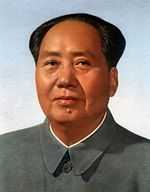Communist Party (Marxist–Leninist) (United States)
| Part of a series on |
| Maoism |
|---|
 |
|
Basic concepts
|
|
Key books
|
| Communism portal |
The Communist Party (Marxist-Leninist) was a Maoist political party in the United States.
History
The Communist Party (Marxist–Leninist)'s predecessor organization, the October League (Marxist-Leninist), was founded in 1971 by several local groups, many of which had grown out of the radical student organization Students for a Democratic Society when SDS split apart in 1969. Michael Klonsky, who had been a national leader in SDS in the late 1960s, was the main leader of the CP(M-L).[1]
The October League came out of the Revolutionary Youth Movement II grouping in the SDS split. During the early 1970s the OL took positions that were at odds with most of the US Left including opposition to Gay liberation and support of the Shah of Iran, whose regime they saw as a bulwark against Soviet social-imperialism.[2] The OL established influence within some of the established civil rights organizations, including the Southern Christian Leadership Conference and the Southern Conference Educational Fund, which had been under the influence of the Moscow oriented Communist Party USA. In late 1975 they organized a "National Fight Back Conference" which drew 1,000 participants and was attended by representatives of the August 29th Movement, the Congress of Afrikan People and the Marxist-Leninist Organizing Committee of San Francisco. They also had a youth group called the Communist Youth Organization.[3]
In June 1977, the October League transformed itself into the Communist Party (Marxist-Leninist), with Klonsky as chairman and Eileen Klehr as vice-chairman. The CP(ML) was recognized by the Communist Party of China as their de facto fraternal party in the US. Klonsky and Klehr visited Peking in July 1977 and met with Hua Guofeng. Longtime Black communist Harry Haywood who had become a CP(M-L) member, also visited met with Chinese leader in June 1978.[4] Also in 1978 Daniel Burstein, the editor of the CP(ML) central organ The Call, and three others, made an eight day tour of Khmer Rouge ruled Cambodia, then a Chinese ally. He visited Phnom Penh as wall as Siem Reap, Kompong Thom, Kompong Cham and Takéo provinces and had an interview with Ieng Sary. In an op-ed he wrote in the New York Times he claimed that there was no evidence of genocide, claiming that that was part of a propaganda campaign orchestrated by the régime's enemies. He did concede, however:
The new government has had to deal with many forces that oppose the revolution -- former Lon Nol officials, as well as organized networks of American, Russian and Vietnamese agents trying to overthrow the Government. Such sabotage has undoubtedly been met with violent suppression. In the course of this, there may even have been some excesses, which no revolution is immune to.[5]
In early 1980 the CP(ML) condemned the Soviet invasion of Afghanistan and called on President Carter to give aid to the Afghan forces opposing the Soviets, end its arms embargo on China and refrain from selling the USSR any "strategic materials". They also saw the Mariel exodus as evidence that the USSR and Castro had "betrayed" the Cuban Revolution.[6]
Further reading
- On the October League's Call for a New Communist Party: A Response by the Proletarian Unity League. New York : United Labor Press, 1976
See also
- Communist Party USA (Marxist-Leninist)
Footnotes
- ↑ Chronology of Political Events, 1954-1992, Part Four 1975-1980. Max Elbaum. Retrieved from Revolution In The Air: Sixties Radicals Turn to Lenin, Mao and Che, March 18, 2010. "1977 August 12–18: Eleventh Congress of the Chinese Communist Party. Mao and the Cultural Revolution are given positive assessments but the Congress officially declares the Cultural Revolution ended. That same month, CPC chair Hua Guofeng and U.S. CP(M-L) chair Mike Klonsky exchange toasts at banquet for CP(M-L) leaders in Beijing; this is effective recognition of the CP(M-L) as the semi-official pro-China party in the U.S."
- ↑ Alexander, Robert J. Maoism in the developed worldWestport, Conn. Prager 2001 p.31
- ↑ Alexander, p.32
- ↑ Alexander, p.32
- ↑ Daniel Burstein. (1978, November 21). On Cambodia: But, Yet. New York Times (1923-Current file),A21. Retrieved April 3, 2011, from ProQuest Historical Newspapers The New York Times (1851 - 2007). (Document ID: 120965532).
- ↑ Alexander, pp.32-33
External links
- Wildcat at Mead a film produced by the October League
- Lessons from the Collapse of the Communist Party (Marxist-Leninist) by Carl Davidson